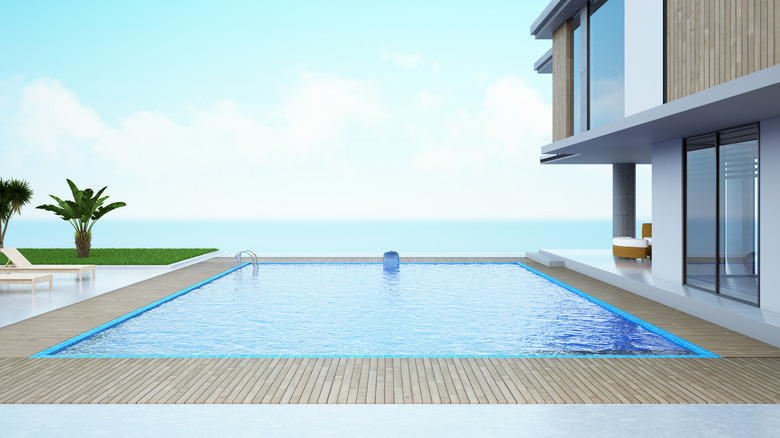Hidden Downsides To Consider Before Getting A Saltwater Pool
For those sensitive to chlorine, a saltwater pool may seem like an excellent alternative investment in your home, offering a way to keep the pool crystal clean and sanitary. They tend to be more affordable to maintain without the need for constant chlorine purchases, and they lack that tell-tale chlorine smell. Yet, there are some downsides to investing in a saltwater pool you must consider before installing one, especially a larger, inground pool. Some drawbacks include using a salt-chlorinator electrode cell, which also requires routine cleaning and has a hefty price. You also have to deal with getting salt on a routine basis, which means a bit of heavy lifting.
Take a few minutes to understand the difference between saltwater pools and chlorine pools. Consider going to a friend's home with a saltwater pool to get a feel for the water and learn about the necessary maintenance and upkeep. There's nothing quite like the smooth feel of the water in this type of pool, especially if it reminds you of being in the ocean and doesn't cause damage to your skin. It may be the perfect investment for your home if you can overcome the downsides of a saltwater pool.
Saltwater pools cost more to install
Many factors play a role in the cost of installing a pool, including your location, the size, and the type of pool itself, such as inground or above ground. The average cost to install a saltwater pool on a national basis is between $12,000 and $38,000, with an average cost of about $25,000 for an inground pool. That's a bit more than the average cost of installing a chlorine pool, which is about $23,000. You may pay less to convert an existing chlorine pool to a saltwater one, which is an option if you already have the inground structure in place.
If you don't already have one, installing a concrete inground pool can cost as much as $50,000 to $200,000, while fiberglass range from $9,000 to $40,000. Vinyl is a mid-range option ranging from $20,000 to $63,000. Work with the pool companies in your area to determine which material is best suited for the environment. You'll also want to determine which building codes may impact the size and type of pool installed.
There are additional costs to consider, though. For example, you'll need a generator called a salt-chlorinator electrode cell. These can be expensive, with costs of around $1,000 for the generator and about $300 to $600 for the salt cells. You'll need to remove and replace the salt cell, which is the component that adds the salt to the water itself, every five or so years.
Other downsides to a saltwater pool
Salt is a natural product, which can make it seem like a safer bet for those that don't want to deal with chlorine, but it has some additional disadvantages, including being corrosive. It can damage the structure of the pool, leading to deterioration that may require expensive repairs down the road. Other items in the area, including the ladder, lights, and handrails, may break down sooner in these pools as well.
Also, when repairs are necessary, or you are considering an upgrade, you'll need to find a saltwater pool expert, which is not as easy to do as finding a pool professional. Be sure to find out who is in your area that can teach you how to maintain your pool and be available for repair needs.
You'll need to maintain your saltwater pool according to manufacturer instructions, which typically include having the salt cell cleaned routinely. Cleaning is done with muriatic acid, a somewhat dangerous material. Also, if you live in a climate where it freezes during the winter, you may still need to use chlorine-related products to winterize the pool if the saltwater system is not enough to keep up with the drop in temperatures.


